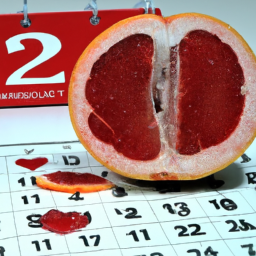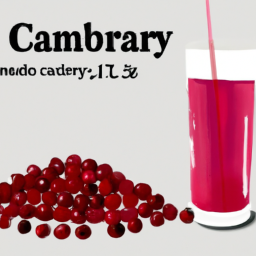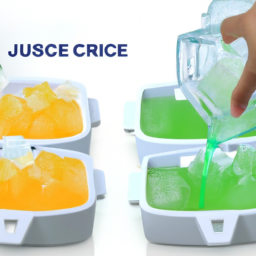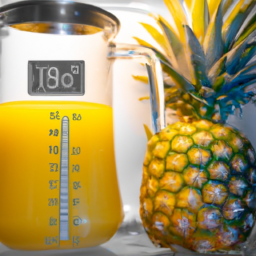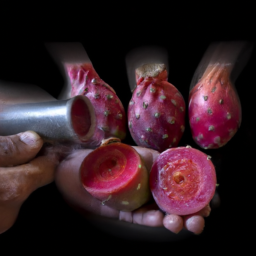As a grapefruit juice enthusiast, I often wonder about its shelf life. It’s always disappointing to taste spoiled juice and have to throw it out. That’s why I decided to do some research to find out how long grapefruit juice stays good for consumption.
First things first, grapefruit juice is a perishable item that doesnt last forever. However, the length of time it stays good for depends on a few factors, such as how its stored and whether or not its been opened.
In this article, Ill be delving into all the details about the shelf life of grapefruit juice, as well as sharing tips for how to extend its lifespan and how to tell if its gone bad. So, lets get started!
Key Takeaways
- Freshly squeezed grapefruit juice should be stored in an airtight container in the fridge.
- Adding citric acid or vitamin C can help preserve flavor and prevent spoilage.
- Store-bought grapefruit juice should be refrigerated and consumed within a week of opening.
- Freezing grapefruit juice in ice cube trays can extend its lifespan for up to six months.
The Shelf Life of Grapefruit Juice
Don’t throw out that grapefruit juice just yet – it’s good for up to a week in the fridge! But, how do you extend its shelf life beyond that? There are a few ways to preserve grapefruit juice for longer periods of time.
One way is to freeze it in ice cube trays and then transfer the frozen cubes to a freezer-safe container. This not only extends the life of the juice but also makes it convenient to use in smoothies or as a flavoring for water or other beverages.
Another way is to add a small amount of citric acid or vitamin C to the juice before storing it in the fridge. This can help preserve the flavor and prevent spoilage. Consuming grapefruit juice regularly has many benefits, including aiding in digestion, boosting the immune system, and even potentially reducing the risk of certain diseases. So, by preserving your grapefruit juice, you can continue to enjoy its benefits for longer periods of time.
When it comes to storing grapefruit juice, there are a few things to keep in mind. It’s important to always store the juice in a tightly sealed container in the fridge, away from any sources of heat or light. Additionally, it’s a good idea to consume the juice as soon as possible after opening the container to ensure the best flavor and quality.
By following these tips, you can extend the life of your grapefruit juice and continue to reap its many benefits.
How to Store Grapefruit Juice
Properly storing freshly squeezed grapefruit juice is crucial to preserving its taste and nutrients. When storing homemade grapefruit juice, it’s best to keep it in an airtight container in the refrigerator. This will prevent oxidation and keep the juice from spoiling too quickly.
If you plan on drinking the juice within a day or two, simply refrigerating it may suffice. However, if you want to extend its shelf life, consider freezing the juice in ice cube trays and transferring the cubes to a freezer-safe container.
Preservatives in store-bought grapefruit juice may extend its shelf life, but they can also affect the taste and nutritional value of the juice. If you do choose to purchase store-bought grapefruit juice, store it according to the manufacturer’s instructions. Typically, it should be kept refrigerated and consumed within a week of opening.
By properly storing grapefruit juice, you can enjoy its refreshing taste and health benefits for longer. Now, let’s move on to some tips for extending the shelf life of grapefruit juice.
Tips for Extending the Shelf Life of Grapefruit Juice
To keep your freshly squeezed grapefruit juice from spoiling too soon, you need to be mindful of grapefruit juice preservation and storage techniques.
One way to extend the shelf life of grapefruit juice is to store it in the freezer using the ‘ice cube method’. This involves pouring the juice into ice cube trays and freezing them. Once frozen, the grapefruit juice cubes can be transferred to a freezer-safe container or zip-top bag for storage. This method not only preserves the juice’s flavor and nutrients but also provides a convenient way to add a refreshing burst of citrus to drinks or recipes.
Another way to extend the shelf life of grapefruit juice is to store it in the refrigerator. However, it’s important to note that grapefruit juice can only last up to 3-4 days in the fridge.
To make sure your grapefruit juice stays fresh, store it in an airtight container and keep it away from direct sunlight. Additionally, avoid storing grapefruit juice in the door of the fridge, as this area is subject to temperature fluctuations.
By following these tips, you can prolong the shelf life of your grapefruit juice and ensure that it stays fresh and flavorful for as long as possible. Moving on to the next section, let’s discuss ways to tell if grapefruit juice has gone bad.
Ways to Tell if Grapefruit Juice has Gone Bad
When it comes to grapefruit juice, it’s important to know how to tell if it’s gone bad. I rely on my senses to determine if it’s still safe to consume. By examining the smell, appearance, and taste of the juice, I can quickly determine if it’s past its prime.
Here are some ways to tell if grapefruit juice has gone bad:
- Smell: If the juice has a sour or rancid odor, it’s a sure sign that it’s gone bad.
- Appearance: If the juice has turned a darker color or has visible mold, it’s time to toss it out.
- Taste: If the juice tastes off or has a strange, bitter aftertaste, it’s not worth drinking.
By paying attention to these cues, you can avoid drinking spoiled grapefruit juice and protect your health.
Smell
You can easily tell if your grapefruit juice has gone bad just by taking a whiff of it. The smell is one of the most noticeable indicators of spoilage. If the juice smells sour, off, or rancid, it’s time to throw it out.
However, there are ways to reduce the smell during storage. To prevent the juice from going bad too quickly, store it in an airtight container in the fridge. This will help retain its freshness and prevent it from absorbing any odors from other foods in the fridge.
Another way to make the most out of your grapefruit juice is by using it in cooking. Grapefruit juice can add a tangy flavor to marinades, dressings, and even desserts. By incorporating grapefruit juice into your cooking, you’ll not only add flavor but also reduce the likelihood of it going bad before you can use it up.
Moving on to appearance, there are a few things to look out for to determine if your grapefruit juice has gone bad.
Appearance
The appearance of spoiled grapefruit juice can be easily spotted by noting any changes in color or consistency. Preservation techniques and packaging options can also play a role in the juice’s appearance. If it has been exposed to air, light, or heat for too long, the juice may appear darker in color and less translucent. Additionally, if the juice has been stored in a container that is not airtight, it may have developed a layer of mold on the surface. Finally, if the juice has been frozen and thawed multiple times, it may have separated and become chunky in texture.
To ensure that your grapefruit juice stays fresh as long as possible, it is important to store it properly. One option is to keep it in the refrigerator in an airtight container, which will help to preserve its color and consistency. Another option is to freeze the juice in an ice cube tray and then transfer the cubes to a freezer-safe container. This method will allow you to thaw only the amount of juice you need at a time, reducing the risk of spoilage. By using these preservation techniques and packaging options, you can enjoy fresh grapefruit juice for longer periods of time.
As for taste, it is important to note that the appearance of the juice can often be a good indicator of its flavor. Spoiled juice may have a sour or bitter taste, and may even taste a bit funky. In the next section, we will explore how to determine if grapefruit juice has gone bad by examining its taste.
Taste
Indulging in a sip of spoiled grapefruit juice can leave a revolting taste in your mouth. The sourness of the juice becomes more pronounced, and the bitterness increases. It’s essential to store grapefruit juice properly to maintain its taste and freshness.
One way to enhance its flavor is to pair it with food. Grapefruit juice can be a refreshing addition to salads, smoothies, and other dishes. The acidity of the juice can also cut through the richness of fatty foods, making it a suitable accompaniment to dishes like fried chicken or pork belly.
When grapefruit juice spoils, it loses its distinct flavor profile. The once-refreshing juice turns into an unpleasant drink that shouldn’t be consumed. To avoid this, it’s crucial to understand how long grapefruit juice lasts and how to store it correctly.
In the next section, I’ll discuss how to discard spoiled grapefruit juice and the steps to prevent it from spoiling too quickly.
How to Discard Spoiled Grapefruit Juice
When it comes to discarding spoiled grapefruit juice, there are a few proper disposal techniques that I always follow.
First off, I make sure to dispose of it in a way that won’t harm the environment. This means considering options like recycling and composting, which can help to minimize waste and reduce my impact on the planet.
Proper Disposal Techniques
Don’t let your expired grapefruit juice become a ticking time bomb in your fridge – it’s time to give it a proper send-off! Proper waste management is crucial to reduce the environmental impact of our everyday actions.
When disposing of spoiled grapefruit juice, the first step is to check if your local waste management system accepts liquid waste. If they do, pour the expired juice into a sealable container and dispose of it properly. This will help prevent leakage and odors that can attract pests and cause pollution.
If your local waste management system doesn’t accept liquid waste, don’t pour it down the drain or toilet. This can harm water treatment facilities and cause water pollution. Instead, mix the expired grapefruit juice with equal parts water and use it to fertilize your plants. The nutrients in the juice will help your plants grow healthy and strong. Once you’ve used the mixture, rinse the container with water and recycle it.
Proper disposal of expired grapefruit juice not only helps prevent pollution but also promotes sustainable waste management practices.
Now that you know how to properly dispose of spoiled grapefruit juice, let’s talk about recycling.
Recycling
You can easily reduce your environmental impact by recycling. It’s a simple process that involves taking used materials and transforming them into new products.
Here are three ways you can incorporate creative recycling into your daily routine:
-
Repurpose: Instead of throwing away old items, consider finding new uses for them. For example, you can turn an old t-shirt into a reusable grocery bag or transform a cardboard box into a storage container.
-
Upcycle: Take old items and turn them into something new and useful. For instance, you can turn an old tire into a planter or transform a glass bottle into a vase.
-
Use Eco-Friendly Alternatives: Instead of buying new items, look for eco-friendly alternatives. For example, you can use reusable cloth napkins instead of disposable ones or opt for cloth shopping bags instead of plastic ones.
By incorporating these creative recycling and eco-friendly alternatives into your daily routine, you can make a positive impact on the environment.
Now, let’s move onto the next topic of composting.
Composting
If you’re looking to add some natural fertilizer to your garden, composting is a great way to recycle organic waste and turn it into nutrient-rich soil. Composting benefits not only your plants but also the environment. By composting, you reduce the amount of organic waste that ends up in landfills, which in turn reduces the amount of methane gas produced by decomposing organic matter.
Composting methods can vary depending on the amount of space you have, the type of waste you have, and how much time you want to spend on the process. Some popular methods include backyard composting, vermicomposting (using worms to break down organic matter), and hot composting (using high temperatures to speed up the decomposition process). To help you decide which method is best for you, here is a table outlining the pros and cons of each method:
| Method | Pros | Cons |
|---|---|---|
| Backyard Composting | Easy to do, low cost, creates high-quality compost | Takes up space, can attract pests |
| Vermicomposting | Requires little space, produces nutrient-rich liquid fertilizer (worm tea) | Requires careful maintenance, worms can die in extreme temperatures |
| Hot Composting | Fast process, kills weed seeds and pathogens | Requires more effort and materials, needs high temperatures |
Composting is a simple way to turn your kitchen scraps and yard waste into a valuable resource for your garden. Now, let’s explore alternative uses for grapefruit juice.
Alternative Uses for Grapefruit Juice
Got extra grapefruit juice? Use it to make a tangy marinade for your chicken or fish! Grapefruit juice can be a versatile ingredient that can be used in a variety of creative recipes, both in the kitchen and in your beauty routine.
Here are some alternative uses for grapefruit juice that you may not have considered:
- Mix grapefruit juice with honey and apply it to your face as a natural toner. The vitamin C in grapefruit juice can help brighten and even out your skin tone.
- Add grapefruit juice to your favorite smoothie recipe for a burst of citrus flavor. Grapefruit is rich in antioxidants and can help boost your immune system.
- Use grapefruit juice as a natural stain remover for clothing. Simply mix the juice with some salt and apply it to the stain before washing.
- Combine grapefruit juice with olive oil and use it as a salad dressing. The acidity in grapefruit juice can help tenderize tough greens like kale.
- Make a grapefruit margarita by combining grapefruit juice with tequila and lime juice. It’s a refreshing twist on a classic cocktail.
In addition to these alternative uses, grapefruit juice also offers a variety of health benefits. It’s a good source of vitamin C, which can help boost your immune system and protect against chronic diseases. Grapefruit juice may also help lower cholesterol levels and improve digestion. It’s important to note that grapefruit juice can interact with certain medications, so be sure to talk to your healthcare provider before adding it to your diet.
Health Benefits of Grapefruit Juice
Rich in vitamin C and antioxidants, grapefruit juice is a nutritious beverage that may offer various health benefits. The nutritional value of grapefruit juice is impressive, as it contains high amounts of vitamin C, potassium, and folate.
Vitamin C is essential for immune function and skin health, while potassium helps regulate blood pressure and supports heart health. Folate, on the other hand, is crucial for cell growth and development, making it particularly important for pregnant women.
In addition to its nutritional value, grapefruit juice has been studied for its potential health benefits. Some studies suggest that regularly consuming grapefruit juice may help lower cholesterol levels and improve digestion. However, it’s important to note that grapefruit juice may also have potential side effects, such as interacting with certain medications and causing gastrointestinal discomfort. Therefore, it’s always best to consult with a healthcare professional before adding grapefruit juice to your diet.
As we move into the next section discussing the comparison to other juices, it’s worth noting that while grapefruit juice may offer unique health benefits, it’s important to consider the sugar content and potential side effects before consuming it regularly.
Comparison to Other Juices
I’ve been curious about how grapefruit juice compares to other juices and how to make it last longer. Can you freeze grapefruit juice? How long does fresh grapefruit juice last? And finally, how can we make grapefruit juice last longer?
Let’s dive into the details and compare grapefruit juice to other juices on the market.
Can you freeze grapefruit juice?
If you’re looking to save some grapefruit juice for later, you can freeze it in airtight containers or ice cube trays. Freezing grapefruit juice is a great way to extend its shelf life, and it won’t affect the taste or nutritional value of the juice.
Here are some tips on how to freeze grapefruit juice:
- Pour the juice into a freezer-safe container, leaving some space at the top for expansion.
- Label the container with the date so you know when you froze it.
- If using ice cube trays, pour the juice into the trays and freeze. Once frozen, transfer the cubes to a freezer-safe container or bag.
Now that you know how to freeze grapefruit juice, you may be wondering how long fresh grapefruit juice lasts.
How long does fresh grapefruit juice last?
To keep your taste buds refreshed, you’ll want to drink that freshly squeezed grapefruit juice within three to four days of juicing it. Fresh grapefruit juice is highly perishable and can spoil quickly if not stored properly.
One way to preserve grapefruit juice is to freeze it. Simply pour the juice into an airtight container and freeze until needed. Frozen grapefruit juice can last up to six months in the freezer.
Another way to make grapefruit juice last longer is to mix it with other ingredients to make recipes using grapefruit juice. For instance, mixing grapefruit juice with honey, ginger, and lemon juice can make a refreshing and healthy drink. Grapefruit juice can also be used as an ingredient in salad dressings, smoothies, and marinades.
By incorporating grapefruit juice into different recipes, you not only extend its shelf life but also create new and exciting flavors. So, how to make grapefruit juice last longer? Let’s find out in the next section.
How to make grapefruit juice last longer?
Want your fresh grapefruit juice to stay fresh for longer? Try freezing it in an airtight container and it’ll last in the freezer for up to six months! Here are some ways to preserve grapefruit juice and the best containers for storing grapefruit juice:
-
Freeze it in ice cube trays: This is a great way to have grapefruit juice on hand for smoothies or other recipes. Simply pour the juice into ice cube trays and freeze. Once frozen, transfer the cubes to an airtight container or freezer bag.
-
Use a glass jar with an airtight lid: Glass jars are a great option for storing grapefruit juice because they are non-reactive and won’t impart any unwanted flavors to the juice. Make sure to choose a jar with an airtight lid to prevent any air from getting in.
-
Use a plastic bottle with a tight-fitting lid: Plastic bottles are a convenient option for storing grapefruit juice because they’re lightweight and easy to transport. Look for bottles with a tight-fitting lid to prevent any air from getting in.
-
Keep it refrigerated: If you don’t want to freeze your grapefruit juice, make sure to keep it refrigerated in a glass or plastic container with an airtight lid. This will help it stay fresh for up to a week.
By following these tips, you can ensure that your grapefruit juice stays fresh and delicious for as long as possible. So go ahead and buy that extra bag of grapefruits knowing that you can enjoy them for weeks to come!
Frequently Asked Questions
Can I freeze grapefruit juice?
Did you know that grapefruit juice can be frozen for up to six months? Freezing options include ice cube trays or freezer-safe containers. While freezing may alter the texture, the nutritional benefits remain intact.
What are some common additives in store-bought grapefruit juice?
Grapefruit juice additives can include preservatives like sodium benzoate and citric acid. Freshness indicators such as expiration dates and storage conditions vary. Homemade options offer health benefits and greater control over nutritional value, flavor variations, and serving suggestions.
How does the shelf life of fresh-squeezed grapefruit juice compare to store-bought?
When it comes to fresh squeezed versus store bought grapefruit juice, the packaging impact is significant. While store bought juice may have preservatives and a longer shelf life, fresh squeezed offers more nutrients and a shorter shelf life.
Can I mix grapefruit juice with other liquids to extend its shelf life?
Mixing preservatives or natural alternatives can extend the shelf life of grapefruit juice when stored properly. However, the specific duration of preservation depends on the ingredients used and the storage conditions.
How long does grapefruit juice last once it has been opened?
As for opened grapefruit juice, it should be stored in the refrigerator at all times to extend its shelf life. Signs of spoilage include a sour smell and a change in color or texture. Remember, "an ounce of prevention is worth a pound of cure."
Conclusion
Well folks, that’s a wrap! Hopefully, this article has given you a better understanding of how long grapefruit juice lasts, how to store it properly, and how to tell if it’s gone bad.
Remember to always check the expiration date and give it a sniff test before consuming. In conclusion, grapefruit juice is a delicious and nutritious beverage that can last up to a couple of weeks when stored correctly. However, if you find yourself with spoiled juice, don’t fret!
There are alternative uses for it, such as in marinades or as a natural cleaner. So next time you reach for that carton of grapefruit juice, remember these tips to ensure a longer shelf life and a tasty drink every time.
Until next time, stay juicy!
Ilana has been a vegan for over 10 years. She originally made the switch for health reasons, but soon found herself becoming more and more passionate about the ethical and environmental implications of a vegan lifestyle. Ilana is the author of The Graceful Kitchen, a blog all about veganism. She loves to cook up delicious and nutritious vegan meals, and share her recipes with others who are interested in leading a cruelty-free life. Ilana is also a strong advocate for using whole foods as the foundation of a healthy diet, and believes that going vegan is one of the best ways to achieve this.
